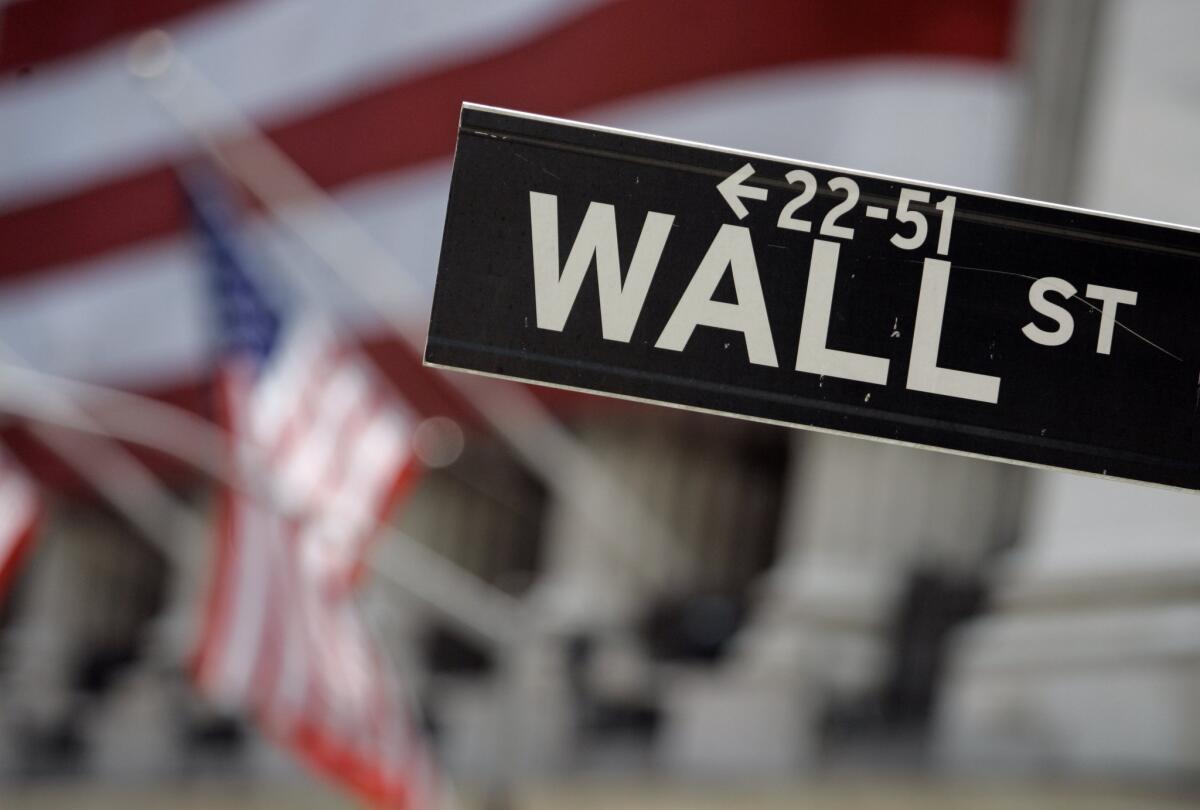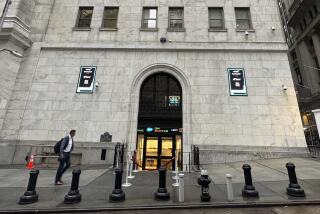Stocks edge up; Amazon, Walmart and Netflix reach record highs

- Share via
Even in this new stay-at-home, increasingly jobless economy, some businesses are making out as clear winners, and gains for Amazon, healthcare companies and stocks in other pockets of the market helped prop up Wall Street on Thursday.
The Standard & Poor’s 500 index flipped between small gains and losses — ending with a gain of 0.6% — after the government reported that 5.2 million Americans filed for unemployment benefits last week. The report was universally regarded as awful, and it brought the total for the last month to roughly 22 million. But markets had braced for a number that was even more awful, which helped limit losses for stocks.
The S&P 500’s Thursday move was one of its mildest since the coronavirus outbreak began knocking stocks lower two months ago. But it belied some churn underneath, as losers in the index outnumbered winners.
Amazon, Dollar General and Walmart all closed at record highs as people stock up on staples. Netflix also reached an all-time high as people spend more time than ever at home. Healthcare stocks in the S&P 500 rose 2.2%, the biggest gain among the 11 sectors that make up the index.
The losers in the coronavirus pandemic, meanwhile, took yet more hits. United Airlines sank 11.5% — one of the biggest slides in the S&P 500 — after its chief executive told employees that demand for travel “is essentially zero and shows no sign of improving in the near term.”
As a sector, financial stocks weighed heaviest on the market, with banks continuing their weeklong slide. Worries are high that business-shutdown orders — and the layoffs they’re causing — will force households and businesses to default on billions of dollars of loans. JPMorgan Chase shares fell 3.8%, and Citigroup slid 5.5%.
Shopping-mall owners and energy companies were also hit hard. Simon Property Group lost 13.3%. Occidental Petroleum declined 10.4%.
Analysts see the separation of winners and losers as an encouraging sign for the market. Earlier in the sell-off, fears about the impending recession weighed down stocks across sectors.
“We had a market that was dotted with indiscriminate selling,” said Quincy Krosby, chief market strategist at Prudential Financial. “Now you have a differentiation within the market, which indicates a healthier backdrop.”
The S&P 500 rose 16.19 points to 2,799.55. The Dow Jones industrial average edged up 33.33 points, or 0.1%, to 23,537.68, and the Nasdaq jumped 139.19 points, or 1.7%, to 8,532.36. The Russell 2000 index of smaller-company stocks fell 5.89 points, or 0.5%, to 1,178.09.
The market’s momentum picked up in the last minutes of trading as the White House prepared to discuss guidelines outlining a phased approach to reopening businesses, schools and other areas of life.
Treasury yields fell again and remain extremely low, though, which shows how pessimistic investors are about the economy’s prospects. The yield on the 10-year Treasury fell to 0.60% from 0.64%. Yields fall when bond prices rise. Investors tend to bid up Treasurys when they’re worried about the economy.
Thursday’s meandering trading offered a milder microcosm of the up-and-down lurches that stocks have been cycling through in recent weeks as traders try to guess how long and how deep the coronavirus-triggered recession will be.
On one hand, investors see the severe economic damage caused by the pandemic. Besides the jobless report, data released Thursday showed that home builders broke ground on fewer homes than expected last month. A survey of manufacturers in the mid-Atlantic region fell below the low point during the Great Recession.
On the other hand, some optimistic investors are focusing on massive aid for the economy promised by the Federal Reserve and the U.S government. They also point to recent signs that the outbreak may be leveling off in some of the world’s hardest-hit areas, which could open the path to reopening parts of the economy.
The dueling sentiments have helped the S&P 500 nearly halve its loss since falling from its mid-February record high. Stocks were down nearly 34% in late March, but a recent rally has trimmed the loss to roughly 17%.
Ultimately, many professional investors say they expect the market to remain volatile until the worst of the outbreak passes.
“This is a consumer-led economy,” said Prudential’s Krosby. “The question is: At what point does the consumer feel comfortable enough to begin even a quasi-normal life outside their homes?”
In Europe, Germany’s DAX rose 0.2%, France’s CAC 40 slipped 0.1% and the FTSE 100 in London added 0.5%.
In Asia, Japan’s Nikkei 225 fell 1.3%. Hong Kong’s Hang Seng dropped 0.6%, and the Kospi in South Korea was virtually flat.
More to Read
Inside the business of entertainment
The Wide Shot brings you news, analysis and insights on everything from streaming wars to production — and what it all means for the future.
You may occasionally receive promotional content from the Los Angeles Times.










